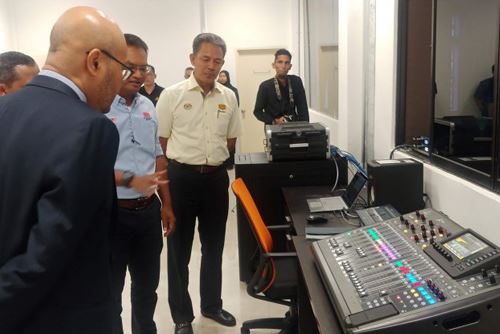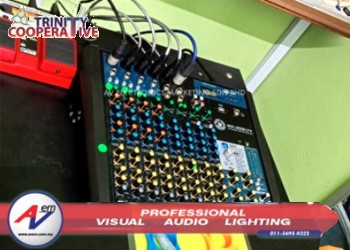AVEM Classroom 01 - Waveforms & Digital Signal Basics
Analog and Digital Waveforms
AV industry is making transitions from analog transmission, recording and processing to digital. Why is this important? In the AV industry, you will work with some analog equipment, more digital equipment, and some equipment that combines analog and digital. You need to understand both techologies.
.jpg)
As you can notice, there is an apparent difference between analog and digital waves. The first charactheristic is the constantly flowing line. The second charactheristic is the changing amplitude over time. Digital information is represented by sequences of the numbers 1 and 0. In a digital waveform, the wave looks like a series of rectangles where the voltage rapidly swings between either high voltage (on) or low-voltage (off) states.
Digital Signal Basics
Many inputs to AV systems arrive in analog form, such as sound pressure waves impacting a microphone diaphgram, pressure from a finger touching a tablet, or light focused onto a camera sensor. The goal of any analog to digital conversion process is to create an accurate digital representation of the original analog signal.
The first step is to create an accurate snapshot of the level of the analog waveform at a particular time, a process known as sampling.That sampled level is then converted into binary numerical value in the digitization process. Determining an acceptable sampling rate is crucial to obtaining a digital representation that resemble the original signal.
.png)
the Nyguist -Shannon sampling theorem tells us that an analog signal can be reconstructed if it is encoded using a sampling rate that is greater than twice the highest frequency being sampled, as shown. For example, if we want to accurately sample audible sounds that occur in the frequnecy range from 20Hz to 20kHz, then the sampling rate should be higher than 40kHz.
The figure shows the differences between an analog signal and a digital sample of the analog signal is in the top. Notice how there is a smooth transition from white at the top to black at the bottom. The image on the bottom represents the digital sample of the analog image. Notice the image appears to be made of diffferent blocks, or six samples.
.png)
- active loudspeaker
- active speaker
- active subwoofer
- alto
- analog crossover
- analog equalizer
- analog mixer
- audiocenter
- b205d
- behringer
- bmb
- bosch
- box speaker
- church
- column speaker system
- convention center
- csp-610
- csp612
- css1720
- csw-115
- da2250
- da2500
- dad-500
- dad950
- dar-350h
- dcx2496le
- digital loudspeaker management
- digital mixer
- digital snak2
- digital snake
- dl16
- dlm408plus
- dm220
- dm24.8
- dm-24.8
- dm48.20
- dpe-2.10
- dpm4.13mk2
- dsp5211
- dsppa
- dsspa
- dvs-4t
- ea5118
- education
- emix
- emma-120b
- emma-835zsmkll
- empa-8250mkii
- empa-8500
- empa-8500 mkii
- empa-8500mkll
- emws884
- emws884b
- emws-884w
- ep1500
- ep2000
- ep512
- fbq-1502
- fbq-1502hd
- fbq3102hd
- hm1461fx
- hm822fx
- ic electronics
- iq15
- iq18b
- iva
- iva audio pack
- karaoke
- kfc
- kla210
- kla210dsp
- kla210wp
- kla218
- kla218dsp
- kla28
- kla815b
- klark teknik
- km1700
- l65
- l65+l65a
- l65+l65s
- l65a
- lbb-3200/00
- lbc-3200/00
- lbc-3210/00
- line array
- live music venue
- live-8
- loudspeaker
- lt10a
- lt12p
- m18b
- m32
- m32 live
- m7.0mkii
- m-7.0mkii
- ma12
- ma15
- masjid
- microphone
- microphones
- midas
- mixer
- mixing amplifier
- mr-28u
- multipurpose hall
- mxi.1222cfx
- mxi.1422
- mxi.1422cfx
- mxi.1622cfx
- my boss club
- pa sistem untuk masjid
- pa system for auditorium
- pa system for bar
- pa system for cafe
- pa system for church
- pa system for court
- pa system for goverment
- pa system for hall
- pa system for hotel
- pa system for mosque
- pa system for multipurpose hall
- pa system for restaurant
- pa system for school
- pa system for temple
- pa system for worship
- passive loudspeaker
- passive subwoofer
- pc260
- pf-118b+wp
- pf-12+wp
- pf-15+wp
- pm827
- pm8270
- pm-8270
- power amplifier
- power mixer
- powered mixer
- pro-12.0
- pro256dx
- pro26dx
- pro7.0
- pro-9.0
- proel
- pro-ud2
- ps15r2
- qx602mp3
- rx10mk2
- rx-10mk2
- rx12mk2
- rx-12mk2
- rx15mk2
- rx-15mk2
- rx-5mk2
- s16
- s32
- sa3118
- sa312
- sa315
- shure
- smaart tuning
- stadium
- stage monitor
- sub118b
- sub-118b
- subwoofer
- t2208
- tannoy
- test test
- tfx122m-an
- th20/tu60ml
- topp pro
- tpm2.3
- tpm-2.3
- tpx-122m
- turbosound
- u2004ch4
- uum
- ux34d
- v4fx
- ve-20
- vp1220
- wd12av2
- wd15av2
- weather proof loudspeaker
- wing
- wireless microphone
- ws740
- x10
- x10a
- x12a
- x15
- x15a
- x1622usb
- x1832usb
- x32
- x32 compact
- x32 producer
- x8
- x8a
- xenyx x1204usb
- xenyx x2442usb
- xr18



















